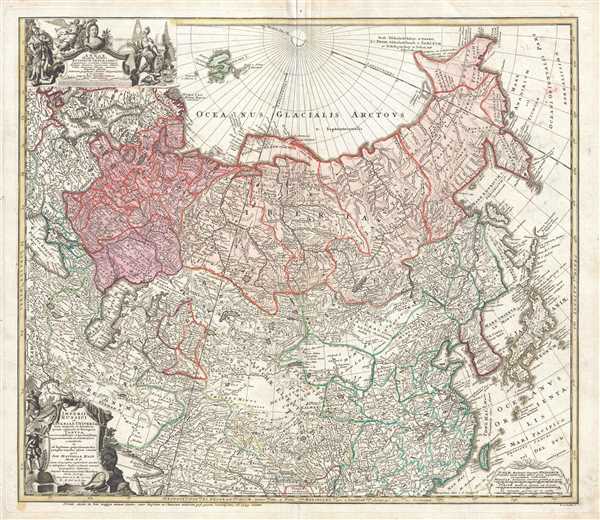This item has been sold, but you can get on the Waitlist to be notified if another example becomes available, or purchase a digital scan.
1739 Hase and Homann Heirs Map of Russia and Asia
ImperiiRussici-homannheirs-1739
Title
1739 (dated) 19.5 x 23 in (49.53 x 58.42 cm) 1 : 4000000
Description
A highly detailed map, myriad cities, towns, and villages are labeled, including Moscow, St. Petersburg, Berlin, and Peking. The Black Sea, Caspian Sea, and Aral Sea are all illustrated, along with numerous rivers and lakes. The Volga, Ganges, and Yangtze Rivers are among the rivers illustrated. A decorative title cartouche is situated in the lower left corner, while a cartouche bearing the map's dedication occupies the upper left corner. A cartouche containing the map's scale is included in the lower right corner.
This map was created by Johann Matthias Hase and published by Homann Heirs in 1739.
CartographerS
Johann Matthias Hase (January 14, 1684 - September 24, 1742) was a German cartographer, historical geographer, mathematician, and astronomer. Born in Augsburg, Hase was the son of a mathematics teacher, thus exhibited skill at mathematics early in life. He began attending the University of Helmstedt in 1701, where he studied mathematics under Rudolf Christian Wagner and then moved to the University of Leipzig to pursue a master's degree. He received his master's in 1707 and promptly returned to Augsburg to work as a teacher. However, he soon returned to Leipzig to serve as court master for two Augsburg patricians. There he became increasingly involved with geography, astronomy, and cartography as adjunct to the philosophical faculty. Hase was recommended for the position of chair of higher mathematics at the University of Wittenberg by his former professor, Christian Wolff, in 1715, but he was rejected. Five years later in 1720, however, he was named Professor of Mathematics at the University of Wittenberg. It is unclear exactly when Hase began working with the Homann Heirs firm, but he Hase compiled numerous maps under that imprint. He was also a prolific writer, publishing several treatises on universal history. More by this mapmaker...
Homann Heirs (1730 - 1848) were a map publishing house based in Nuremberg, Germany, in the middle to late 18th century. After the great mapmaker Johann Baptist Homann's (1664 - 1724) death, management of the firm passed to his son Johann Christoph Homann (1703 - 1730). J. C. Homann, perhaps realizing that he would not long survive his father, stipulated in his will that the company would be inherited by his two head managers, Johann Georg Ebersberger (1695 - 1760) and Johann Michael Franz (1700 - 1761), and that it would publish only under the name 'Homann Heirs'. This designation, in various forms (Homannsche Heirs, Heritiers de Homann, Lat Homannianos Herod, Homannschen Erben, etc..) appears on maps from about 1731 onwards. The firm continued to publish maps in ever diminishing quantities until the death of its last owner, Christoph Franz Fembo (1781 - 1848). Learn More...

